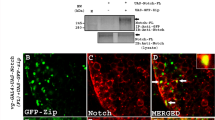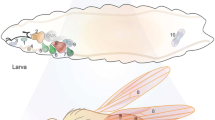Abstract
To establish the vertebrate body plan, it is fundamental to create left–right asymmetry in the lateral-plate mesoderm to correctly position the organs. However, it is also crucial to maintain symmetry between the left and the right sides of the presomitic mesoderm, ensuring the allocation of symmetrical body structures, such as the axial skeleton and skeletal muscles. Here, we show that terra is an early left-sided expressed gene that links left–right patterning with bilateral synchronization of the segmentation clock.


Similar content being viewed by others
References
Meng, A. et al. Development 126, 1259–1268 (1999).
Brunner, B. et al. Genomics 77, 8–17 (2001).
Dubrulle, J. & Pourquié, O. Development 131, 5783–5793 (2004).
Jiang, Y.J. et al. Nature 408, 475–479 (2000).
Holley, S.A. et al. Genes Dev. 14, 1678–1690 (2000).
Oates, A.C. & Ho, R.K. Development 129, 2929–2946 (2002).
Cooke, J. & Zeeman, E.C. J. Theor. Biol. 58, 455–476 (1976).
Vermot, J. et al. Science 308, 563–566 (2005).
Kawakami, Y. et al. Nature 435, 165–171 (2005).
Vermot, J. & Pourquié, O. Nature 435, 215–220 (2005).
Hamada, H. et al. Nature Rev. Genet. 3, 103–113 (2002).
Long, S. et al. Development 130, 2303–2316 (2003).
Hashimoto, H. et al. Development 131, 1741–1753 (2004).
Amack, J.D. & Yost, J. Curr. Biol. 14, 685–690 (2004).
Hamburger, V. & Hamilton, H.L. J. Morphol. 88, 49–92 (1951).
Essner, J.J. et al. Development 127, 1081–1093 (2000).
Raya, A. et al. Nature 427, 121–128 (2004).
Kimmel, C.B. et al. Dev. Dyn. 203, 253–310 (1995).
Thisse, C. & Thisse, B. in Zebrafish Science Monitor 5, 8–9 (1998).
Henrique, D. et al. Nature 375, 787–790 (1995)
Acknowledgements
We thank S. Wilson and D. Stemple for the zebrafish embryos, M. Tada and C.-P. Heisenberg for reagents, I. Campos for technical support with MO injections, A. Gaspar for histological work, C. Domingues for the SDS–PAGE gels and I. Marques for sequence analysis. We are grateful to S. Thorsteinsdóttir, S. Simões, W. Wood, S. Rodrigues, R. Andrade, A. Jacinto and A. Coutinho for comments on the manuscript. This work was supported by a grant from Fundação para a Ciência e a Tecnologia (FCT) (POCTI/45914/BCI/2002). L.S. was supported by a FCT fellowship (SFRH/BPD/6755/2001). R.L. was supported by Fundação Calouste Gulbenkian (FCG)/Instituto do Emprego e Formação Profissional (IEFP). The authors are members of the FP6 European Network of Excellence 'Cells into Organs'.
Author information
Authors and Affiliations
Corresponding author
Ethics declarations
Competing interests
The authors declare no competing financial interests.
Supplementary information
Supplementary Information
Supplementary figure S1, S2, S3, S4 and Supplementary methods (PDF 459 kb)
Rights and permissions
About this article
Cite this article
Saúde, L., Lourenço, R., Gonçalves, A. et al. terra is a left–right asymmetry gene required for left–right synchronization of the segmentation clock. Nat Cell Biol 7, 918–920 (2005). https://doi.org/10.1038/ncb1294
Received:
Accepted:
Published:
Issue Date:
DOI: https://doi.org/10.1038/ncb1294
- Springer Nature Limited
This article is cited by
-
Genome-wide identification and comparative analysis of Dmrt genes in echinoderms
Scientific Reports (2023)
-
Identification of Dmrt2a downstream genes during zebrafish early development using a timely controlled approach
BMC Developmental Biology (2018)
-
Pan-metazoan phylogeny of the DMRT gene family: a framework for functional studies
Development Genes and Evolution (2014)
-
The low expression of Dmrt7 is associated with spermatogenic arrest in cattle-yak
Molecular Biology Reports (2014)
-
Expanding roles for the evolutionarily conserved Dmrt sex transcriptional regulators during embryogenesis
Cellular and Molecular Life Sciences (2013)





